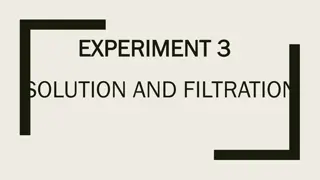Partitioning and Purification of Carboxymethyl Cellulase in Aqueous Biphase System
Cellulases enzymes are essential in various industries and purifying them is crucial for understanding their properties. Conventional techniques along with aqueous biphasic systems like liquid-liquid fractionation are used for extraction and separation. The latter enables selective partitioning of biomaterials, making it a flexible and efficient method for purification. Comparison highlights the simplicity, biocompatibility, and cost-effectiveness of the aqueous biphasic system over conventional methods.
Download Presentation

Please find below an Image/Link to download the presentation.
The content on the website is provided AS IS for your information and personal use only. It may not be sold, licensed, or shared on other websites without obtaining consent from the author.If you encounter any issues during the download, it is possible that the publisher has removed the file from their server.
You are allowed to download the files provided on this website for personal or commercial use, subject to the condition that they are used lawfully. All files are the property of their respective owners.
The content on the website is provided AS IS for your information and personal use only. It may not be sold, licensed, or shared on other websites without obtaining consent from the author.
E N D
Presentation Transcript
PARTITIONING AND PURIFICATION OF CARBOXYMETHYL CELLULASE IN AQUEOUS BIPHASIC SYSTEM EXTRACTION MUINAT OLANIKE KAZEEM, UMI KALSOM MD SHAH, AZHARI SAMSU BAHARUDDIN AND NOR AINI ABDULRAHMAN DEPARTMENT OF BIOPROCESS TECHNOLOGY UNIVERSITI PUTRA MALAYSIA
OUTLINE Introduction Overview Problem statement Objective Methodology Results and Discussion Conclusion References Acknowledgement
Overview Cellulases enzymes are proteins belonging to the family of glycosyl hydrolases and found wide application in food, textile, animal feed, pulp and paper and biofuel industries. Commercial cellulase are majorly produced from fungi, however bacterial cellulase in presently gaining recent attention. Purification of cellulase is required to gain complete understanding of its properties. The application of conventional protein purification techniques have been useful in the downstream processing of cellulase.
Overview Ammonium sulphate purification Ion exchange chromatography Membrane filtration Gel filtration
Overview Aqueous biphasic system is a liquid-liquid fractionation technique that enables selective partitioning by extraction, separation and purification of biomaterials such as proteins, membranes, viruses and enzymes from complex mixtures. This system is formed by mixing the solutions of two mutually incompatible polymers or polymer/ salt above critical concentrations (Polyethylene glycol). PEG SALT The basis of separation is the uneven distribution of biomaterials between two phases, both having high water content.
Overview This high water content combined with the low interfacial tension of the system allows non-destructive partitioning of sensitive biomaterials and is often refered as biocompatibility and can also be used in preservation of the enzyme Partitioning is governed by numerous factors such as molecular weight PEG (hydrophobicity) pH, crude load, temperature, salt concentration. This can be manipulated to achieve desired separation and purification results, which makes ATPS very flexible for the application.
Comparison between conventional purification and Aqueous biphasic system Conventional purification Aqueous biphasic system Laborious Simple Special equipment 10 ml falcon tube Sephadex/salt Polyethylene glycol/salt Difficult scale up Easy scalability Require multiple steps Can be done in single step Enzyme loss Biocompatible Longer processing time Shorter processing time Expensive Cheap
Problem Statement Conventional purification are cumbersome and expensive
OBJECTIVE To optimize aqueous biphasic system parameters for extraction and purification of carboxymethylcellulase
Methodology ABS-carboxymethyl cellulase PEG selection Salt selection Effect of NaCl Effect of crude Effect of pH
Analysis Patition co-efficient K =?? ?? ? ?? ????????? ???????? ? Specific activity SA = ?? ?? ?? ??????? ?? ?? ? ??? ?????? ?? ?? ????? ???? ????? Purification factor P ??= Yield (Y) (%) =?????? ???????? ?? ?????? ? ??? ?????? ???????? ?? ????? ???????
RESULTS AND DISCUSSION Table 1: Selection of various bottom phase (salt) for CMCase stability Type of bottom phase Concentration (%, w/w) Cellulase activity (U/mL) Phosphate 5 26.55 0.62 10 25.38 0.56 20 22.93 0.21 Magnesium sulphate 5 21.53 0.09 10 19.15 0.31 20 15.45 0.18 Ammonium sulphate 5 26.41 0.43 10 25.06 0.46 20 21.51 0.28 Sodium citrate 5 28.59 0.21 10 26.28 0.43 20 21.49 0.53 Sodium acetate 5 25.55 0.51 10 23.98 0.31 20 20.71 0.21
Table 2: Influence of PEG molecular weight on the partitioning behaviour of carboxymethyl cellulasee PEG MW PEG/Citrate Partition Purification Yield (%) (g/mol)/ composition coefficient (K) factor (PFT) (%,w/w) 20.5/15 0.63 1.63 47.11 4000 20.5/15 0.52 3.32 58.89 6000 20.5/15 0.32 6.18 68.72 8000 20.5/15 0.58 1.96 50.34 10,000
Result and Discussion 0.6 90 Pattition coefficient (K) 0.55 80 0.5 70 0.45 60 Yield (%) 0.4 50 0.35 40 0.3 30 0.25 20 0.2 10 0.15 0.1 0 0 5 10 15 20 25 Crude load (%) K yield Figure 1: Influence of crude load on the partionning behaviour of cellulase
Results and Discussion In this case, as the pH of ABSE was increased above the pI of cellulase, the cellulase becomes negatively charged which then was attracted to the positively charged PEG to phase there by reducing the yield of cellulase (Ratanapongleka, 2010) 0.45 80 Partition coefficient (K) 0.4 78 0.35 76 0.3 Yield (%) 74 0.25 0.2 72 0.15 70 0.1 68 0.05 0 66 5 5.5 6 6.5 7 7.5 8 8.5 pH K Yield Figure 2: Influence of pH on partitioning behaviour of cellulase
Results and Discussion Addition of NaCl could cause the disruption of water structure due to greater electrical potential between the PEG and salt phase, thus enhancing the interaction of cellulase with the phase component (Settu et al., 2015). 12 88 86 10 Purification factor 84 8 Yield (%) 82 6 80 78 4 76 2 74 0 72 0 0.5 0.75 1 1.25 NaCl %, (w/w) Yield PFT Figure 3: Inflence of NaCl on the partitioning behaviour of cellulase
Result and Discussion Figure 4: SDS-PAGE analysis of cellulase recovery in PEG8000/citrate ABS
CONCLUSION Aqueous biphsic system parameters at 14 % (w/w) crude load , 1 % NaCl, pH 7.0 produced optimum recovery of CMCase at a yield (Y) of 86.62 %, a partition coefficient (K) of 0.21 and purification factor (PFT) of 10.3 from the bottom phase of PEG 8000/sodium citrate The results from this study has demonstrated that aqueous biphasis system can be potentially be used to purify carboxymethylcellulase from fermentation broth of B. licheniformis 2D55
ACKNOWLEDGMENTS The author acknowledge the organization for women in science for developing countries (OWSD) for providing scholarship for this research and university of Ilorin Nigeria for granting leave of study
REFERENCES Azadian, F., Badoei-dalfard, A., Namaki-Shoushtari, A. and Hassanshahian, M. (2016). Purification and biochemical properties of a thermostable, haloalkaline cellulase from Bacillus licheniformis AMF- 07 and its application for hydrolysis of different cellulosic substrates to bioethanol production. Molecular Biology Research Communications, 133-145. Ho, S. L., Lan, J. C.-W., Tan, J. S., Yim, H. S.andNg, H. S. (2017). Aqueous biphasic system for the partial purification of Bacillus subtilis carboxymethyl cellulase. Process Biochemistry. Kazeem, M. O., Shah, U. K. M. Baharuddin, A. S. and AbdulRahman, N. A. (2016). Enhanced Cellulase Production by a Novel Thermophilic Bacillus licheniformis 2D55: Characterization and Application in Lignocellulosic Saccharification. BioResources, 11(2), 5404-5423 Sofijan, H., Shun, T. J., Abbasiliasi, S., Mustafa, S., Puspaningsih, N. T., Kadkhodaei, S., et al. (2017). Recovery and partial purification of thermophilic -xylosidase derived from recombinant Bacillus megaterium MS941 by aqueous two-phase system. Separation Science and Technology, 52(5), 834- 842. 5. Yin, L. J., Lin, H. H. and Xiao, Z.-R. (2010). Purification and characterization of a cellulase from Bacillus subtilis YJ1. Journal of Marine Science and Technology, 18(3), 466-471























